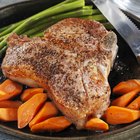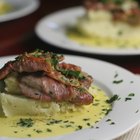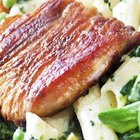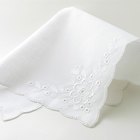
PeteerS/iStock/Getty Images
Veal is a chameleonlike meat, offering skilled cooks a range of cooking options and sauces. One simple but much-loved preparation is the veal cutlet, a piece of veal pounded thin and breaded. These are traditionally fried, a technique that scores high for flavor but less so for health. By breaking from tradition, you can improve the healthfulness of the dish and still enjoy the delicate flavor of veal.
The Fundamentals
As with many classic dishes, frugality inspired veal cutlets. A piece of veal that might only yield two or three thick chops can provide thin-pounded cutlets for a large family, a key consideration in the centuries when meat was an occasional luxury, rather than a daily staple. Once bulked up with breadcrumbs the thin slices of veal gave the impression of a generous portion, and the crumbs made them more filling. Pounding the veal also made it possible to use tougher cuts from the leg or breast, because it physically frays the dense muscle fibers and makes the meat easier to chew.
Frying Lighter
Frying the cutlets ensures a richly golden crust of breadcrumbs and correspondingly satisfying flavor, but it also adds fat to the finished dish. The key to making fried cutlets more healthful is careful selection of your cooking fat. For example, Wiener schnitzel is traditionally cooked in clarified butter, which adds a wonderful flavor but also a significant quantity of saturated fat. Choosing a fat higher in monounsaturates, such as mid-oleic sunflower oil, avocado oil, grapeseed oil or an extra-light olive oil, can make the dish significantly heart-healthier. If you're preparing the cutlets as part of a Mediterranean-inspired dish, you might use extra-virgin olive oil as your cooking fat to infuse the cutlets with flavor.
Taking It to the Sheet
If you'd rather not fry veal cutlets, consider baking them. A parchment-lined sheet pan can hold a lot of cutlets, which is especially convenient when you're having company. Spray each cutlet lightly with pan spray or an oil mister, choosing your oil as carefully as you would for frying. Turn the cutlets and mist them again, so there's a fine layer of oil on each. The oil helps your cutlets brown and crisp, giving a flavor similar to that of fried veal, but with much less fat in the finished dish.
Dare to Bare
The golden coat of breading protects the veal from the heat of cooking, aside from its culinary and visual appeal. But the same thin sheets of veal are served undressed in many equally authentic and traditional recipes. Thin sheets of uncoated veal are usually referred to as paillards or escalopes, and they're much loved for their tenderness and exceptionally rapid cooking. Brush them lightly with herbed oil and grill or broil them briefly, until just done, for an elegant accompaniment to rice and vegetables.
Related Articles
Can I Use White Vinegar to Tenderize ...
How Long Do You Bake Veal Cutlets?

What Are Pork Cutlets?
How to Cook Breaded Tenderloins in the ...

How to Cook Pan-Seared Veal

How to Fry Veal Cutlets

How to Cook Veal Leg Scallopini

How to Cook Tenderized Beef Chuck Steak ...

Secrets to Tender Breaded Pork Chops

How to Cook Frozen Schnitzel
What Is Panko Flour?

How to Cook Venison Inside Loin

How to Cook Turkey Cutlets
How Long Can You Marinate Meat Before ...

Wedding Gifts for a Bride from a ...

How to Keep Breading on Veal Cutlets ...
Why Does My Pork Roast Come Out Dry?

What Cooks Faster: Bone-In or Boneless ...

Ways to Cook a Pork Loin in a Skillet

How to Make a Medieval Jerkin
References
- On Cooking: A Textbook of Culinary Fundamentals; Sarah Labensky, et al.
- Fine Cooking: Veal Cutlets
- Larousse Gastronomique; Prosper Montagne, Editor
Writer Bio
Fred Decker is a trained chef and prolific freelance writer. In previous careers, he sold insurance and mutual funds, and was a longtime retailer. He was educated at Memorial University of Newfoundland and the Northern Alberta Institute of Technology. His articles have appeared on numerous home and garden sites including GoneOutdoors, TheNest and eHow.
Photo Credits
PeteerS/iStock/Getty Images